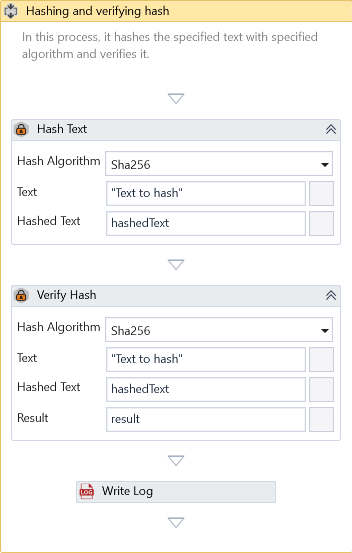Verify Hash
Description
This activity verifies authenticity by comparing the computed Hash of the input text with the provided Hash.
Configuration
Configure the following properties in this activity's user interface to verify the hashed value.
- Hash Algorithm - Specify the Algorithm for hashing the specified text. The following options are available.
| Algorithm | Description |
|---|---|
| MD5 (Message Digest Algorithm 5) | MD5 is a hashing algorithm that generates a 128-bit (16-byte) hash value, often represented as a 32-character hexadecimal number. While once famous for data integrity checks, password hashing, and digital signatures, MD5 is now considered insecure due to vulnerabilities such as collision attacks. It is appropriate for quick integrity checks in non-critical systems but unsuitable for security-sensitive applications. |
| SHA-1 (Secure Hash Algorithm 1) | SHA-1 generates a 160-bit (20-byte) hash value and is used widely for securing data, digital signatures, and certificates. However, due to vulnerabilities, including collision attacks, SHA-1 was deprecated in 2017. Modern cryptographic applications now favor more secure algorithms like SHA-256, as continued use of SHA-1 poses significant risks to data integrity. |
| SHA-256 (Secure Hash Algorithm 256-bit) | SHA-256 is part of the SHA-2 family and produces a 256-bit (32-byte) hash value. It is used widely in secure applications like blockchain technology, SSL/TLS certificates, and password hashing. Its strong resistance to collision and preimage attacks makes it a preferred choice for modern security needs, offering reliable protection against current hardware threats. |
| SHA-384 (Secure Hash Algorithm 384-bit) | SHA-384, also part of the SHA-2 family, generates a 384-bit (48-byte) hash value and is commonly used in high-security environments, including TLS/SSL protocols and digital certificates. It balances enhanced security and computational efficiency, making it ideal for systems handling susceptible data without the higher costs associated with SHA-512. |
| SHA-512 (Secure Hash Algorithm 512-bit) | SHA-512, another member of the SHA-2 family, produces a 512-bit (64-byte) hash value. Its extended hash length provides Exceptional cryptographic security, making it suitable for high-stakes applications such as government communications, classified information protection, and financial transactions. |
- Text - Specify the input text that will be hashed using the chosen algorithm and compare it with the provided hashed text.
- Hashed Text - Specify the hashed value to verify.
- Result - Returns True on match otherwise False.
Properties
Misc
- DisplayName – Add a display name to your activity.
- Private – By default, activity will log the values of your properties inside your workflow. If private is selected, then it stops logging.
Optional
- Continue On Error – Specifies if the automation should continue even when the activity throws an error. This field only supports Boolean values (True, False). The default value is False.
note
If you include this activity in Try Catch and the value of this property is True, it will catch no error during the execution of the project.
Example
Download Example
